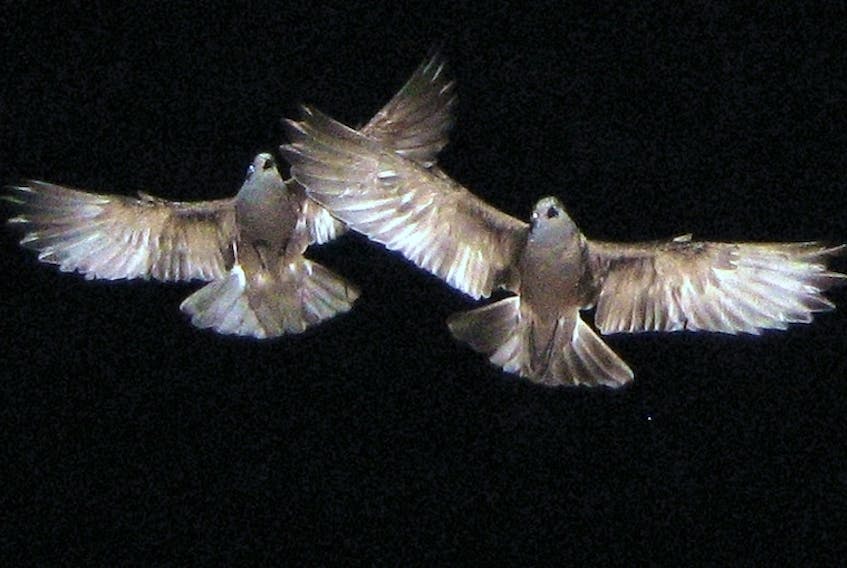ST. JOHN'S, N.L. — At first glance, it doesn’t look like anything special.
The grey/dark green leafy plant-like object with curly white edges growing alongside reddish warts on the trunk of a balsam fir tree could easily be overlooked among all the greenery during a walk in the woods.
But the boreal felt lichen is a big deal for scientists in these parts, as it’s believed more than 90 per cent of the known global population grows in Newfoundland and Labrador, making its health pivotal to its survival as a species.
“Looking for them in the woods is a bit like looking for a needle in a haystack,” said Yolanda Wiersma, a professor in Memorial University of Newfoundland’s (MUN’s) biology department. “But globally, we are one of the hot spots of this species.”
Sadly, the boreal felt lichen’s existence is threatened.
According to government’s wildlife division list of species at risk, the boreal felt lichen is among 42 species which are considered to be either endangered (facing imminent extinction), threatened (likely to become endangered if nothing is done to reverse the decline) or vulnerable (having characteristics that make it particularly sensitive to human activities or natural events).
Twenty-one of the at-risk species in the province are plants, 15 are birds, four are mammals and two are fish. In total, 18 are endangered.
More protection needed?
While the province’s Endangered Species Act provides special protection for many of these at-risk species, some experts believe more should be done.
Wiersma said the boreal felt lichen, which has nearly vanished from places like Scandinavia, grows mostly in this province on the Avalon Peninsula and in the Bay d’Espoir area.
Since it lives on trees, she said, its habitat is disappearing due to forest harvesting for commercial development or personal purposes. It’s also sensitive to air pollution.
“We’re lucky here in Newfoundland because we don’t have a lot of big industries and we’re far enough from the eastern U.S. that we’re not really in that, what people call, the eastern seaboard tailpipe,” said Wiersma, a landscape ecologist who teaches courses in ecology and conversation biology.
In 2008, the Newfoundland and Labrador government put a stop to logging activities in the central Avalon area, which has helped to keep the species in place, she said.
But she said lichen habitat should have a dedicated protected area.
“All species at risk are important simply because biodiversity is important ..,” she said. “If our ecological systems stop functioning, eventually it will affect us … things like filtering water so that we have clean water and filtering the air. It would be difficult to replace these things with technology.”
“If our ecological systems stop functioning, eventually it will affect us …” - Yolanda Wiersma, professor in Memorial University of Newfoundland’s (MUN’s) biology department, ecologist

ENDANGERED SPECIES IN NEWFOUNDLAND AND LABRADOR
(Threatened and vulnerable species not included in this list.)
PLANTS
- Barrens Willow
- Crowded Wormseed Mustard
- Gmelin’s Watercrowfoot
- Griscom’s Arnica
- Long’s Braya
- Low Northern Rockcress
- Mackenzie’s Sweetvetch
- Mountain Bladder Fern
- Northern Bog Aster
- Northern Twayblade
- Rattlesnakroot
- Wooly Arnica
MAMMALS
- Wolverine
BIRDS
- Eskiimo Curlew
- Ivory Gull
- Piping Plover
- Red Crossbill
- Red Knot
FISH
- (None)
“If they’re dying and potentially going extinct because of our activity, then we have to assume responsibility for that.” - Bill Montevecchi, a professor at MUN’s faculty of science
Bill Montevecchi, a professor at MUN’s faculty of science worries about species which may soon be on the at-risk list if prevention measures aren’t taken.
In particular, he said the Leach’s storm-petrel, a small seabird that has the world largest colonies in this province — Baccalieu Island and Witless Bay islands — should be noticed.
In the last 30 years, the populations have declined by half in the province, Montevecchi said — from six to three million.
“That’s really rather shocking,” said Montevecchi, who’s engaged a long-term interdisciplinary ecosystem research program focused on the behavioural ecology of seabirds marine, food webs and biological oceanography. “It’s often abundant species that go extinct.”
Montevecchi said there are four hypotheses why they’re declining — predation by gulls in the breeding colony, food and climate change, mercury pollution in the small fish they eat and, since they’re nocturnal, deaths caused by their attraction to lighting, such as oil platforms flares.
So, why is preserving such species so important?
“It’s important because if they’re dying and potentially going extinct because of our activity, then we have to assume responsibility for that. … We can’t just ignore it because you and I are causing the destruction and mortality.
“We can’t just walk away from that. The future of our species depends on us … It’s not a blame game. It’s about putting in the effort.”
Twitter: TelyRosie









